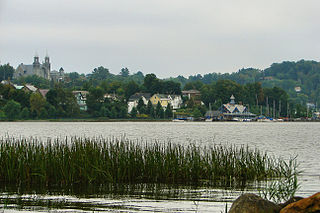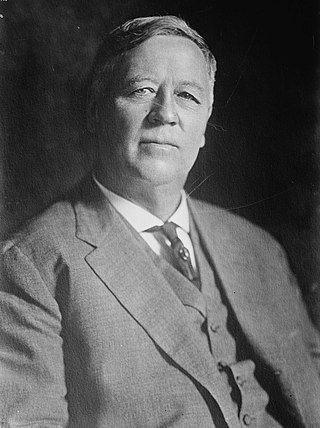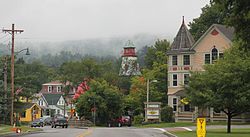
Windsor County is a county located in the U.S. state of Vermont. As of the 2020 census, the population was 57,753. The shire town is the town of Woodstock. The county's largest municipality is the town of Hartford.

Pownal is a town in Bennington County, Vermont, United States. As of the 2020 census, the town population was 3,258. The town of Pownal includes the villages of Pownal, North Pownal, and Pownal Center.

Winooski is a city in Chittenden County, Vermont, United States. Located on the Winooski River, as of the 2020 U.S. census the municipal population was 7,997. The city is the most densely populated municipality in northern New England, an area comprising the states of Maine, New Hampshire, and Vermont. It is the smallest of Vermont's 10 cities by area, though the city of Vergennes has the smallest population. As part of the Burlington, Vermont metropolitan area, it is bordered by Burlington, Colchester, and South Burlington.

Craftsbury is a town in Orleans County, Vermont, United States. The population was 1,343 at the 2020 census. The town includes the unincorporated villages of Craftsbury, Craftsbury Common, Mill Village, and East Craftsbury.

Irasburg is a town in Orleans County, Vermont, United States. Irasburg was established in 1781 when the land was granted to Ira Allen, Roger Enos, Jerusha Enos, Jerusha Enos, Jr., Roger Enos, Jr. and others by the Vermont General Assembly. Ira Allen later obtained the rights of the other proprietors, and he deeded the town to Jerusha Enos, Jr. as a wedding gift.

Saxtons River is an incorporated village in the town of Rockingham in Windham County, Vermont, United States. The population was 479 at the 2020 census. For over a hundred years, Saxtons River has been the home of Vermont Academy, an independent secondary school. Most of the village is a historic district listed on the National Register of Historic Places in 1986 as Saxtons River Village Historic District.

Hartland is a town in Windsor County, Vermont, United States. The population was 3,446 at the 2020 census. It includes the villages of Hartland, Hartland Four Corners, and North Hartland.

White River Junction is an unincorporated village and census-designated place (CDP) in the town of Hartford in Windsor County, Vermont, United States. The population was 2,528 at the 2020 census, up from 2,286 in 2010, making it the largest community within the town of Hartford.

Springfield is a town in Windsor County, Vermont, United States. As of the 2020 census, the population was 9,062.

Middlebury is the shire town of Addison County, Vermont, United States. As of the 2020 census, the population was 9,152. Middlebury is home to Middlebury College and the Henry Sheldon Museum of Vermont History.

Jericho is a town in Chittenden County, Vermont, United States. As of the 2020 census, the population was 5,104. The town was named after the ancient city of Jericho.

Cambridge is a town in Lamoille County, Vermont, United States. The population was 3,839 at the 2020 United States Census. Cambridge includes the villages of Jeffersonville and Cambridge.

Bradford is a census-designated places in the town of Bradford, Orange County, Vermont, United States. The population was 907 at the 2020 census. The village disincorporated on December 1, 2004. The village became a census-designated place in 2008. The central commercial and residential portion of the village is listed on the National Register of Historic Places as the Bradford Village Historic District.

Newbury is a town in Orange County, Vermont, United States. The population was 2,293 at the 2020 census. Newbury includes the villages of Newbury, Center Newbury, West Newbury, South Newbury, Boltonville, Peach Four Corners, and Wells River.

Newport is the only city in and the shire town of Orleans County, Vermont, United States. As of the 2020 Census, the population was 4,455. The city contains the second-largest population of any municipality in the county, and has the smallest geographic area. It is the second-smallest city by population in Vermont. Newport is also the name of neighboring Newport Town.

Ludlow is a town in Windsor County, Vermont, United States. The population was 2,172 at the 2020 census. Ludlow is the home of Okemo Mountain, a popular ski resort. Before becoming a ski destination, Ludlow was originally a mill town, and was the home of a General Electric plant until 1977. It was named after Ludlow, Massachusetts which is less than 100 miles away. There is also a village of Ludlow in the town.

John Garibaldi Sargent was an American lawyer and government official. He served as United States Attorney General during the administration of President Calvin Coolidge.

William Wallace Stickney was an American lawyer and politician. As a Republican, he served as the 48th governor of Vermont from October 4, 1900, to October 3, 1902.

The Black River Academy is a historic school building on High Street in the village of Ludlow, Vermont. Chartered in 1835, the school served as the town high school until 1938. The present building, a Richardsonian Romanesque structure built in 1888, was listed on the National Register of Historic Places in 1972 for its architectural and historic educational significance. It presently houses the Black River Academy Museum, operated by the Black River Historical Society.
Joseph F. Radigan was an American attorney and politician from Vermont. A Democrat, He is most notable for serving as United States Attorney for the District of Vermont from 1961 to 1969.
























